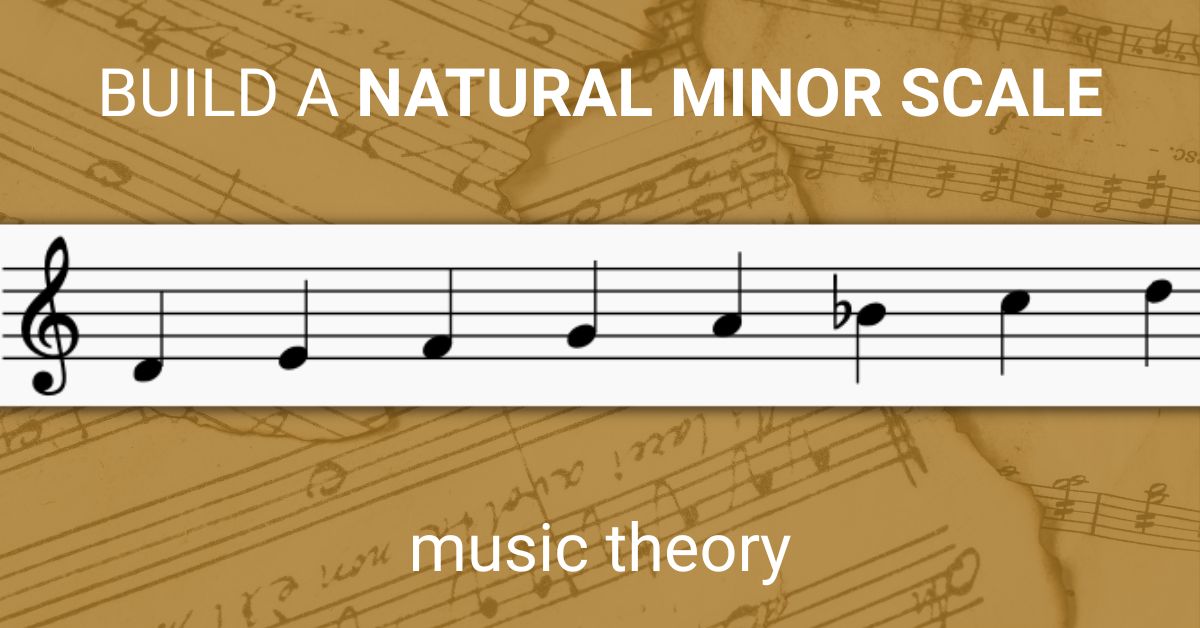How to Build a Natural Minor Scale
Published April 27, 2020 by Taras (Terry) Babyuk
Introduction
The natural minor scale is one of three main types of minor scales (the others being the harmonic minor and melodic minor). Although not as common as the other two, it is extremely useful to know, at the very least because it provides the basis for deriving the other two minor scales. The natural minor scale follows a particular pattern of whole steps and half steps (formula) which gives it the quality that we refer to as "natural minor".
By the end of this article, you should be comfortable building a natural minor scale from any note!
Building a Natural Minor Scale
We can build a natural minor scale in one of two ways: using a formula (pattern of whole steps and half steps) or using its relative major scale. Let's take a look at each of these methods in turn.
Method #1: The Formula
All scales follow a specific pattern of whole steps and/or half steps (a formula), and the natural minor scale is no exception. The "formula" for the natural minor scale looks like this:
Method #2: The Relative Major Scale
As you might know from music theory, every minor scale has what we call a "relative major" scale associated with it. These two scales will always share the same key signature. This means that as long as we know the key signatures of our major scales well, it will be exactly the same for their relative minor scales!
If this sounds unclear or complicated at the moment, don't worry! We will work through several examples together below.
Putting It to Practice
Example 1: Building "A Natural Minor Scale"
1. Using the Formula
For our first task, let's build the A Natural Minor scale. Starting from the note "A", let's begin applying our formula:
"A" to "B" gives us a whole step, "B" to "C" is a half step, "C" to "D" is a whole step, "D" to "E" is a whole step, "E" to "F" is a half step, "F" to "G" is a whole step, and "G" to "A" is a whole step. This means that the A Natural Minor scale is made up of the notes "A", "B", "C", "D", "E", "F", "G", and (repeated) "A".
As we can see, this scale only uses the white keys on the piano, which makes it very beginner-friendly to learn and play.
2. Using the Relative Major Scale
Now, let's build the same scale using the "Relative Major Scale" method. There are two steps to this process.
Step 1: Find the relative major of A Minor
The quickest way to find the relative major of any minor key is to simply count up 3 half steps.
Counting 3 half steps from "A" brings us to "C", which means C Major is the relative major of A Minor.
Step 2: Apply the key signature of the relative major scale to the natural minor scale
Remember that natural minor scales use the same key signature as their relative majors. Because C Major has no sharps or flats, the A Natural Minor doesn't either. So, our result looks like this:
Here is what the A Natural Minor scale looks like written down on the music staff:
Example 2: "D Natural Minor Scale"
1. Using the Formula
Let's apply our formula pattern starting from D:
"D" to "E" gives us a whole step, "E" to "F" gives us a half step, "F" to "G" is a whole step, "G" to "A" is a whole step, "A" to "B♭" is a half step, "B♭" to "C" is a whole step, and "C" to "D" is a whole step. Therefore, D Natural Minor is made up of "D", "E", "F", "G", "A", "B♭", "C", and "D".
2. Using the Relative Major Scale
Step 1: Find the relative major of D Minor
Step 2: Apply the key signature of the relative major scale to the natural minor scale
The relative major of D Minor turns out to be F Major. F Major has one flat in its key signature, which is a B♭. Therefore, D Natural Minor will also have a B♭.
Here is what the D Natural Minor scale looks like written down on the music staff:
Example 3: "C Sharp Natural Minor Scale"
Let's end with a more complex example, just for practice.
1. Using the Formula
C♯ Natural Minor is made up of "C♯", "D♯", "E", "F♯", "G♯", "A", "B", and "C♯".
2. Using the Relative Major Scale
Step 1: Find the relative major of C# Minor
Step 2: Apply the key signature of the relative major scale to the natural minor scale
E Major has 4 sharps in its key signature: "F♯", "C♯", "G♯", and "D♯". Applying these to the natural minor gives us:
Here is what the C♯ Natural Minor scale looks like written down on the music staff:
Conclusion
Hopefully you now have a solid understanding of how to build the Natural Minor Scale. As mentioned earlier, this scale forms the basis for building the harmonic and melodic minor scales, so knowing it well will serve you well in your musical journey. Best of luck!
Just fill out our quick trial lesson form and wait to hear from us within 1-2 business days. If you like your trial lesson, you can sign up for regular lessons with us! Our lessons are available online (Zoom or Skype) as well as in-person if you live close to our location. Start learning your favorite instrument with one of our amazing teachers today!
